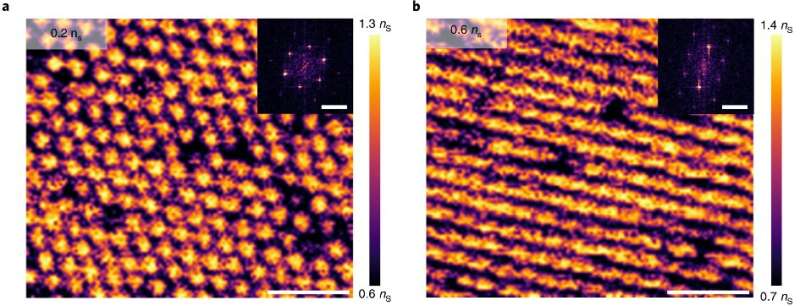January 31, 2022 feature
Study unveils a Moiré nematic phase in twisted double bilayer graphene

Moiré superlattices are systems in which two sheets of a material are placed on top of each other with a small angle misalignment, resulting in a characteristic pattern known as the Moiré pattern. In recent years, many physicists and material scientists have been investigating the properties of these materials, as they can exhibit superconductivity and other interesting phases or characteristics.
Researchers at Columbia University and other institutes worldwide have recently unveiled the presence of a Moiré nematic phase in twisted double bilayer graphene, a graphene-based Moiré superlattice. This finding, presented in a paper published in Nature Physics, could pave the way toward a better understanding of these widely studied material structures.
"My group and several others have been interested in the properties of twisted van der Waals materials such as graphene, after it was discovered that these materials can host interesting quantum phases like superconductivity in 2018," Abhay N. Pasupathy, one of the researchers who carried out the study, told Phys.org. "The simple question we wanted to answer is, what other kinds of interesting quantum phases could these materials exhibit? So in a sense, ours was an open search without a preconceived goal."
A nematic phase, such as the one that Pasupathy and his colleagues observed in twisted double bilayer graphene, is a state first seen by the spontaneous arrangement of molecules in parallel patterns, where they are all facing the same direction. This phase is often observed in liquid crystals, but it can also be found in other materials.
"Imagine that you purchased a bunch of baguettes from the store and you do not organize them well, just toss them into a giant bag," Pasupathy explained. "If you look inside the bag, each baguette will be pointing in a random direction. Now, if you start shaking the bag and try to make it more compact, you will find that many of the baguettes will line up with each other and will all point in the same direction. That direction could have been anything, but eventually they pick some direction to all be lined up in."
The example offered by Pasupathy summarizes what happens in a nematic phase, a state in which individual particles in a material spontaneously line up in a specific direction, producing a directional order. Nematic phases in liquid crystals have been leveraged to create many modern technologies, such as LCD displays. In the case of the material observed by the researchers at Columbia, the constituent particles are electrons.
"The electrons are not pointy like a baguette, but instead one can think of the way electrons move in a solid," Pasupathy said. "If electrons choose to move more along one direction than another, this would be the equivalent nematic phase."
To carry out their experiments, Pasupathy and his colleagues used a precise imaging technique called scanning tunneling microscopy. This technique allows researchers to closely examine individual atoms inside a material and the motion of electrons contained in them.
"Using this method, we were able to 'see' that the electrons were in a nematic phase," Pasupathy explained. "We discovered that when the conditions were just right, the electrons in the material spontaneously entered the nematic phase, and that they could be tuned in and out of this phase at will by applying voltages. As of now, the implication of this work is to show how electrons in these materials can interact with each other in unusual ways, giving rise to unexpected properties."
The results gathered by this team of researchers show that by applying specific voltages to twisted double bilayer graphene one can prompt it to spontaneously enter a nematic phase. In addition, in their paper the suggest that this phase is not associated with the specific structure of the graphene lattice but is instead a phenomenon that could spontaneously emerge in all Moiré lattices.
Currently, many physicists and material scientists are debating and investigating the possible causes for superconductivity and other interesting phases observed in van der Waals materials and Moiré superlattices. One possibility is that the repulsion between electrons in these materials play a crucial role in the emergence of these phases.
While the findings of this recent study do not offer undisputable evidence that this is the case, they show that interactions between electrons can in fact impact the properties of van der Waals materials. In the future, this could inspire similar studies examining the nematic phase observed by the researchers more in depth, as well as the role that electrons might play in eliciting it.
"We now plan to explore other materials in the same category as twisted double bilayer graphene," Pasupathy added. "At this point, the research is still basic science, where we are trying to discover new properties of these materials."
More information: Carmen Rubio-Verdú et al, Moiré nematic phase in twisted double bilayer graphene, Nature Physics (2021). DOI: 10.1038/s41567-021-01438-2
Journal information: Nature Physics
© 2022 Science X Network





















